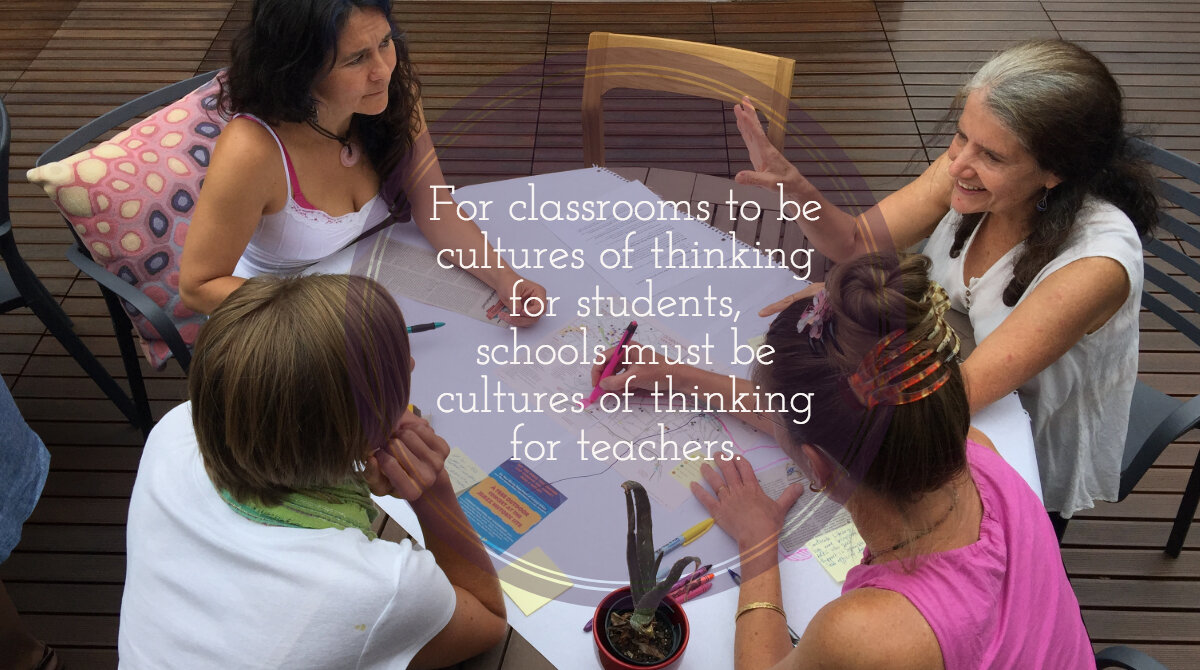
If we support and empower the adults in the school to continually grow, innovate, question, take risks, reflect, examine, inquire, and learn from and with one another;
then teachers will create those same conditions for the students in their classrooms.
Why It Matters
For teachers to be able to create a classroom culture in which students think, inquire, collaborate, discuss, take risks, and learn from mistakes, teachers need to experience such learning for themselves. The way teachers get treated as learners by their ministries of education, state-level education departments, district-level administrators, and school principals, will get mirrored in their classrooms. If teachers are controlled and dictated to, they will control and dictate to their students. By the same token, if teachers are encouraged to innovate, collaborate, and inquire, they will promote these same processes in their classrooms.
We know that when teachers have the opportunity to actively engage in meaningful discussion, planning, and practice, their teaching and student outcomes improve (1). In a randomized, controlled study conducted in schools serving low-achieving students, teachers in the treatment group engaged in active professional learning in which they were immersed in the types of learning activities and environments they would then create for their students. The impact on student outcomes was impressive. Students in the classrooms of teachers in the treatment group performed a full year ahead of those in the control group’s classes on state tests (2).
A culture of thinking is a community that supports teachers’ growth. Teachers need to “feel safe to be vulnerable, to admit failings or mistakes and to trust that their colleagues are giving feedback in order for them to improve” (3). When teachers are part of a culture of thinking, they are more likely to engage in rich conversations about learning, including the discussion of problems, strategies, and solutions. Learning then becomes an “ongoing, collective responsibility rather than an individual one” (4). This kind of authentic collaboration (see Exhibit 1) has a positive effect on student achievement (5, 6). Through collaboration, teachers are better able to reflect on their teaching practice, allowing them to assess if what they are doing works or if changes are needed (7). In a collaborative culture, morale improves and teachers report higher job satisfaction, which contributes to increased gains in student achievement. However, meaningful and sustained collaboration among teachers is too rarely found in schools (8, 9). Without time and opportunities to collaborate, discussions centered around student learning cannot occur. This inevitably leads to less teacher learning and a decline in the quality of instruction (10, 11, 12).
Risk-taking is necessary to drive innovation (13) and create a new story of learning in schools. To build a classroom culture that encourages student risk-taking, teachers need to demonstrate their own willingness to try new things. However, teachers tend to be risk-averse for various reasons, including the fear of being ostracized and the fear of public failure (13). Therefore, a supportive school culture that embraces inquiry and innovation is important in supporting teachers to feel safe enough to take risks. When teachers explore and experiment with new ideas that may not always work, students observe how their teachers react and adapt. This helps students learn the value of failure, to understand that learning is a lifelong process, and that mistakes are a natural part of that process (14, 15).
While school leaders need to be at the forefront of creating a culture of thinking in schools and break with old models of professional learning, teachers themselves must take an active role by respecting their colleagues, being open to new ideas, and approaching the act of teaching as inquirers. When both leaders and teachers see the creation of a culture of thinking as a mutual goal for themselves, then the adults in the school can grow, innovate, question, take risks, reflect, examine, inquire, learn from, and learn with one another (see Exhibit 2). Teachers are then able to create those same conditions for the students in their classrooms.
What It Looks and Sounds Like
Of course, there is no one way that a culture of thinking developed for teachers at a school will look and sound. There is ample room for individuals to put their own creative stamp on things. The list below is a sampling of ideas that might be useful to advance your practice.
Deprivatizing Teaching
Make formal and informal observation in each other’s classrooms a common occurrence.
Use structures and protocols to facilitate teachers’ observation and discussion. For example, use the Snapshot Observation Protocol to foster personal reflections based on classroom observation.
Engage in lesson study or Learning Labs to build a sense of collaborative planning, collective ownership, and communal problem solving.
Use Pineapple Charts or #ObserveMe signs to encourage teachers to open up their classrooms and invite colleagues in for informal observations.
Create a space in the school where teachers can share ideas, pose questions, etc. and not feel like they will be evaluated. This could also be an online space or in the staff room.
Shifting the Conversation
Focus more on exploratory and inquiry conversations that dig into the questions, mysteries, and challenges of teaching and learning. Honor the questions more than the quick answers (see Exhibit 3).
Ground conversations in evidence instead of anecdote. Get in the habit of creating and sharing documentation.
Use thinking routines and protocols to facilitate conversations and discussion among teachers.
Become great listeners as an entire faculty and develop skill at giving feedback.
Set norms for collaboration so that people will feel respected, valued, and listened to.
Prioritizing Time for Teacher Learning
Make sure most staff meetings are about learning and not logistics. This will ensure that they are more authentic and engaging. When information does need to be delivered, consider using emails or Loom videos instead.
Schedule adequate time for teachers to engage in ongoing inquiry, in-depth discussion, and meaningful engagement on at least a bi-weekly basis. Such groups are most effective with they engage teachers across departments and grade levels. Protect that time (16).
Ensure that learning is ongoing, sustained, and cumulative rather than episodic and disconnected. Make sure there will be something to show for all the time spent. How will teachers share their learning and learn from one another?
Don’t confuse “working groups” or committees with “learning groups.” The former is out to complete a job or task, to implement something. The latter seeks to develop understanding of a question, problem, or issue through investigation, action, and reflection.
Involving Teachers in Their Own Learning
Allow teachers to be co-designers of their own learning. Where and how can their questions, problems, and issues drive the learning? When can teachers make meaningful choices in the learning process?
Seek suggestions from teachers on a regular basis.
Involve teachers in setting agendas.
Create conditions for teacher leadership (see Exhibit 4)
Encouraging Innovation and Risk-Taking
Focus on mutual growth and improvement, rather than perfection.
School leaders must model how they are also trying new things, making mistakes, and learning along the way.
Use the language of prototyping rather than implementing. A prototype is a first attempt carried out for the purpose of gathering feedback and learning from one’s efforts. Implementation implies that something is to be fully realized.
Celebrate failure as a learning moment. Regularly engage teachers in conversation about productive failures or First Attempts In Learning: What is something new that you tried this week, and what did you learn from that first attempt? How will you use that learning to reshape or modify your next attempt?
Reflecting on Your Leadership
How am I, and the leadership team as a whole, modeling what it means to be a risk-taker, innovator, learner? Do we reflect on our mistakes and new learnings openly? Do we solicit feedback to facilitate our growth?
Where, when, and how are teachers currently observing their colleagues? How much is structured and how much is informal? How might these opportunities be enhanced and supported further?
What does collaboration look like at this school? Is it deep, meaningful, and generative? Or, is it cursory and mostly focused on work alignment?
What are the current opportunities for teachers to drive, shape, and direct their professional learning? Do teachers make meaningful choices in their professional learning? Where and how can we provide more?
What are the norms, either informal or formal, that we have for our group interactions, discussions, and collaborations? If formally stated, are we holding ourselves accountable to these norms? If informal, what is working and what isn’t? How might we benefit from formally articulating and discussing our norms?
Leaders control a lot of teachers’ time through meetings and sessions. On what are you spending teachers’ time? Is this time generative and focused on student learning?
Reflecting on Your Teaching
How am I tapping into the expertise of my colleagues to improve my practice? Where and when do I seek out feedback, use colleagues as a sounding board, or observe others I want to learn from?
When was the last time I took what I consider to be a real instructional risk in a desire to innovate, try something new, and disrupt the status quo? What did I learn from that? What supports do I need to have in order for that happen more often and to feel comfortable in doing so?
How often am I reflecting on my own practice to better understand the effects of my teaching and needs of my students? What structures have I found that help push my reflection deeper? What other structures (routines or protocols) might I try?
What kind of “teacher dialog” do I bring to the various groups in which I participate? How would I characterize our collective conversations in these groups? What can we do to better support each other in moving to more exploratory and inquiry conversations? (See Exhibit 3)
How am I growing as a professional this year? What am I getting smarter about through my own actions and efforts this year? We want our students to achieve a year’s growth in a school year. Am I achieving a year’s growth as a teacher in a year’s time?
How am I making use of documentation? How do I use it for my own reflection to better understand my students’ learning? Where and when do I share documentation from my classrooms with colleagues in an effort to really understand students’ thinking and development of their understanding?
Using Quick Data to Inform Your Efforts
Construct a survey (download this template to create a survey that fits your school) to find out what kinds of professional learning opportunities (both informal and formal) teachers view as valuable, what they take away from each, how each might be improved, which have the most impact on teaching, and which impact the culture of thinking being created for teachers.
Click on image to enlarge
Questions to Consider from the Quick Data:
How does the data fit with what you expected to see? What is surprising?
What suggestions for improvement warrant more discussion and exploration?
How might you make more time for those opportunities that have the most value and impact?
Are there any opportunities that should be abandoned or rethought?
How will you share this data with the rest of the school to deepen the conversation?
Connection to the 8 Cultural Forces
Opportunities. The kinds of opportunities that we create for teacher learning are key in creating a culture of thinking for teachers. We need to ensure that we create opportunities for reflection, for sustained and ongoing inquiry into practice, for collaboration with colleagues within and across grade levels and departments, for observation, and for teacher voice and choice.
Time. We need to give adequate and sustained time for teacher learning. This often means rethinking our use of time and getting creative. What meetings are necessary? How do we rein in the work agenda so it doesn’t impinge on time for learning?
Routines. Just as students benefit from structures to guide and direct their thinking and discussion, so do teachers. Using protocols can ensure that everyone has a voice and that important elements are addressed and discussed. Protocols help us learn how to interact in a respectful and focused way that benefits everyone’s learning.
Modeling. The word “principal” means main or lead. In schools the principal is the main or lead teacher and learner. Their behavior and actions matter. All school leaders need to be models of risk-taking, reflection, acceptance, questioning, and inquiry. They need to model the thinking and behaviors they want to see in teachers. One way that leaders model is through symbolic conduct, that is, the message being sent through one’s behavior. For instance, a leader who is not present at professional learning sessions sends the message that such sessions are not very important.
Interactions. A key component of rich professional learning is collaboration and interactions with our colleagues. As such it is often useful to start by setting norms for interactions so that people feel they are in a respectful learning space. Learning to listen in a generative way is an important component of this respect. We need our colleagues to challenge us, question us, support us, and reflect with us. Teaching can feel isolating, so we need to deprivatize teaching in order to ensure that we are learning with and from our colleagues.
Language. Using absolute language (is, should) may sound authoritative, but it shuts down exploration and inquiry. Using conditional language (might, could be) allows conversation to stay open and avoid early closure until the issue has been explored. We are accustomed to the language of “professional development,” but what does the word “development” suggest? Do anyone really want to be “developed?” Perhaps a more useful phrase, that many countries use already, is professional learning.
Expectations. School leaders need to communicate expectations that teaching and learning are complex endeavors, and thus continual growth and learning as a teacher is the expectation. Too often ministries of education, state-level departments, district administrators, and schools communicate an expectation of compliance and mastery with top down directives. This often causes teachers to be risk-averse and eschew innovation or novel approaches. Instead, they play it safe.
Environment. The physical environment of a learning space communicates what kind of learning happens there. Is the room set up for collaboration or for paying attention to a single speaker? Where and how is the documentation of teacher learning preserved and displayed?
Mindset #1: Creating a culture of thinking for teachers.
“Teaching has to become, first and foremost, a learning profession; teachers will have to learn to learn in different ways, and reconstruct themselves as advanced specialist practitioners of learning with their pupils as their apprentice.”
“If schools are going to be places where students consistently push against the edge of what they don’t know, testing new theories, and trying things out while learning from mistakes, those same qualities must be present for their teachers. It’s difficult for a teacher to facilitate that type of learning environment if they haven’t experienced it themselves.”
“Our willingness to try and to fail is severely limited when we are not supported by a community that encourages such risks.”
“Relationships serve to motivate and engage us. They provide a supportive context for taking risks. It helps us to know that someone has our back and is cheering for our success even as they are willing to catch us should we fall.”
“Nothing—nothing—has more impact in the life of a child than positive relationships”
Resources
Video
Interview
Podcast
Article
Blog
Research
10 minutes
Teachers need real feedback
In this TED talk, Bill Gates suggests that even great teachers can get better with smart feedback—and lays out a program from his foundation to bring it to every classroom. He makes that case that with no feedback, no coaching, there's just no way to improve.
2 pages
A Global Approach to Teacher Development
Grace Tatter examines effective professional development programs around the world to see what lessons can be drawn. She found that effective programs focus on teacher autonomy and professionalism, while giving educators specific tools to draw from and adapt to their context.
4 pages
How Can Teachers Bounce Back From Failure?
Education Week reporter Madeline Will argues that it is important for teachers to take risks and try new things. Failure will be a natural part of this. That means that teachers need training and support in bouncing back from a bad lesson so that they can "fail forward" and use the experience as an opportunity for growth..
16 Minutes
When a Lesson Goes Wrong
Sarah Wessling, 2010 National Teacher of the Year, teaches a HS English lesson with camera crews from the Teaching Channel in tow. Her lesson on a literary analysis of falls short and she needs to gather information from students and quickly regroup. Later, she debriefs with another teacher. Free registration required to watch.
3 pages
Putting the 'Professional' Back in Teacher Professional Development
Madeline Will reports on a panel discussions sponsored by the Learning Policy Institute that explored the findings and recommendations of the Instructional Leadership Corps. Five key take-aways are articulated.
2 pages
The Right Way to Lead Teacher Learning
Emily Boudreau explores the tools and techniques of effective facilitators — and how they make professional development work. Specific protocols are shared.
6 pages
There’s No I in Teacher: 8 Tips for Collaborative Planning
Rebecca Rufo-Tepper, Director of Professional Development at Institute of Play, discusses how teachers at the Quest to Learn become learning designers when given space to collaborate, cultivate trust, and ensure that work is student relevant. She shares 8 tips for making teaches collaboration effective.
3 pages
The Benefits of Low-Stakes Teacher Evaluation
Summary of a 2019 study (link to full study) from researchers at Harvard, Oxford, and Bristol that found low-stakes peer evaluations resulted in improvements in teacher job performance, as measured by test scores. The study found improvements for both the observed teacher and the teacher doing the observation.
3 pages
Deeper Learning Blog Carnival: Six Questions for Better Professional Development
Bob Lenz, Executive Director of the Buck Institute for Education, the world leader in Project Based Learning reflects on what makes professional development stick? What actually changes practice? He identifies 6 questions that guide his own planning when leading professional learning session.
6 pages
How Pineapple Charts Revolutionize Professional Development
Jennifer Gonzalez describes the use of the Pineapple Chart, a system that allows teachers to invite one another into their classrooms for informal observation, as a tool for professional learning. Teachers “advertise” the interesting things they are doing in their classrooms, activities they think others might want to observe. Two case studies of schools using Pineapple Charts are shared.
6 pages
Why Focusing on Adult Learning Builds a School Culture Where Students Thrive
Deb Helsing and her Harvard colleagues, Robert Kegan and Lisa Lahey, found that when adults continue to learn at their jobs they are better at creating that experience for other people. She says if schools are going to be places where students consistently push against the edge of what they don’t know, testing new theories, and trying things out while learning from mistakes, those same qualities must be present for their teachers.
3 pages
The Place of Reflection in PD
Noting that new classroom strategies, even those supported by research, are often overlooked by teachers, Instructional coach Aaron Marvel asks how can leaders of professional development guide teachers through the process of shifting their beliefs to accept something novel that they’re initially inclined not to accept? He focuses on one response to this question—reflection.
13 minutes
Want to Transform Schools & Yourself? Think Like a Coach!
Jacy Ippolito, an associate professor at Salem State University, talks about how teaching and learning in schools can be transformed when adults in schools adopt the mindset of an instructional coach. This includes working with curiosity, care, and vulnerability, When coaches shed the label of being the “expert” and become open to learning with and from the teachers they coach, they are modeling vulnerability.
4 pages
How to Build Schools Where Adults Learn?
In this paper from the Journal of Staff Development, Kevin Fahey and Jacey Ippolito share insights into how school leaders can support and challenge teachers in their practice to improve their skills for better student outcomes. This involves meeting teachers where they are as well as moving them towards more complex and collaborative ways to work and learn.



















